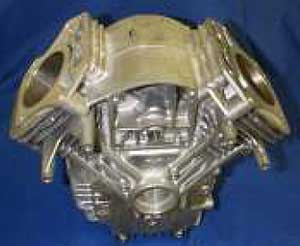|
|
|
|
| Systems Approach |
Advancements
Manufacturers are continually pushing the envelope in regards to what can be accomplished with the singlepass process. Improved tool, fixture, and machine designs have allowed for increased production rates as well as improved bore precision. The following are some of the latest advancements that have been made..
Cross Hatch Patterns:
Another recent development that has been made in the singlepass style of bore finishing includes creating various “cross hatch” or “sine curve” scratch patterns on the finished bores. (The depth and angle of the scratch pattern can vary depending upon the size of the superabrasive grit; material to be finished, and operating speeds and feeds). These patterns are thought to be beneficial in the retaining of oil in engine cylinder bores. This pattern is achieved by feeding a proprietary designed single pass style tool through a bore at a higher than normal feed rate, (which only removes a portion of the parts material) then reciprocate the tool through the bore a number of times at a set spindle speed and feed rate. The spindle speed and feed rate will determine the crosshatch angle. With this method, many of the advantages of the single pass method are obtained, as well as the desired crosshatch pattern.
Adding a controlled peck method to the process may also produce a similar pattern (sine curve). This method allows for the finishing of long uninterrupted bores in even the most gummy of materials by allowing the chip that is produced to be broken up, and a fresh supply of lubricating fluid to enter the work area. This method is also advantageous on applications where it is important to keep the cutting stresses down to an absolute minimum, such as in the finishing of thin walled components. The following case histories illustrate examples of applications where either the “cross hatch” or “sine curve” patterns are produced.
|
|
 |
 |
| Gears being finished with single-pass process. |
|
|
| Case History #6: (Cylinder Bore) |
| |
| Diameter: |
68mm |
Length/Clearance: |
102mm |
| Material: |
Cast Iron |
Hardness: |
|
| Bore Type: |
Thru |
Stock Removal: |
0.035mm |
| Tool Pass #1: |
67.992mm |
Diamond Size: |
140/170 |
| Tool Pass #2: |
68.002mm |
Diamond Size: |
325/400 |
| Tool Pass #3: |
Brush |
|
|
|
| |
| Bore Quality |
Required |
Achieved |
| Size: |
.010mm |
0.005mm |
| Roundness: |
.006mm |
.002mm |
| Straightness: |
.006mm |
.002mm |
| Surface Finish: |
1.6Rz |
1.4Rz |
|
| |
| Machine Type: |
Engis Model # 9425-14S (4 Spindle Machine) |
| Production: |
60 Parts Per Hour |
|
|
| |
| < Prev 1 2 3 4 5 6 7 8 9 10 Next > |
|